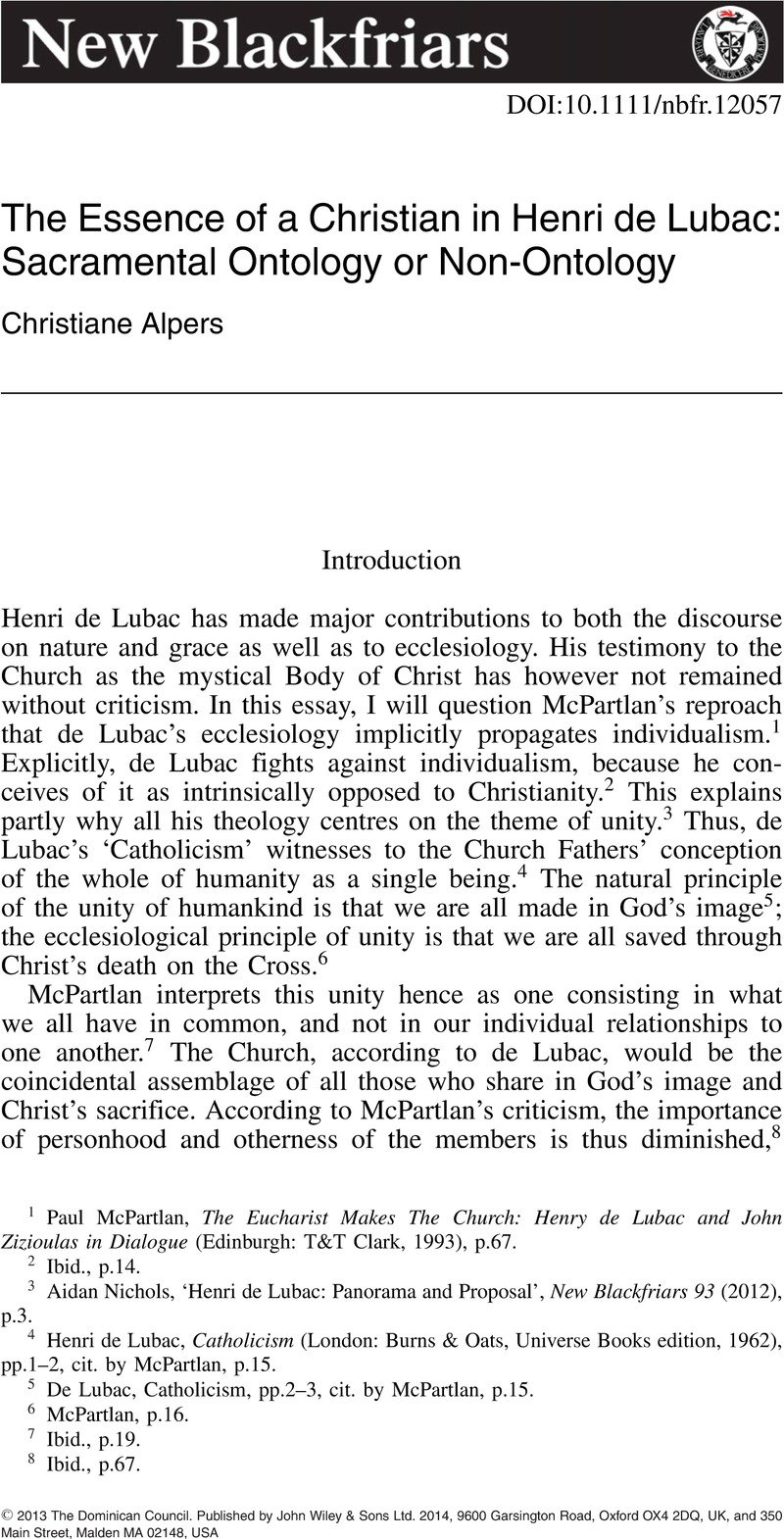Published online by Cambridge University Press: 01 January 2024

1 McPartlan, Paul, The Eucharist Makes The Church: Henry de Lubac and John Zizioulas in Dialogue (Edinburgh: T&T Clark, 1993), p.67Google Scholar.
2 Ibid., p.14.
3 Aidan Nichols, ‘Henri de Lubac: Panorama and Proposal’,New Blackfriars 93 (2012), p.3.
4 Lubac, Henri de, Catholicism (London: Burns & Oats, Universe Books edition, 1962), pp.1–2, cit. by McPartlan, p.15Google Scholar.
5 De Lubac, Catholicism, pp.2–3, cit. by McPartlan, p.15.
6 McPartlan, p.16.
7 Ibid., p.19.
8 Ibid., p.67.
9 The metaphysical analysis of the correlation between substances and accidents in this essay will mainly draw on an argumentation by Pickstock, Catherine, ‘Thomas Aquinas and the quest for the Eucharist’, in Milbank, John and Oliver, Simon, ed., The Radical Orthodoxy Reader (London: Routledge, 2009), pp.265–284Google Scholar.
10 Vorderholzer, Rudolf,Meet Henri de Lubac, His Life and Work, trans. by Miller, Michael J. (San Fransisco: Ingnatius Press, 2008), pp.142–143Google Scholar.
11 Lubac, Henri de, The Discovery of God, trans. by Dru, Alexander (Edinburgh: T&T Clark, 1996), p.87Google Scholar.
12 Ibid.
13 Ibid.
14 Ibid., p.92.
15 Boersma, Hans, ‘Nature and the Supernatural in la nouvelle théologie: The recovery of a sacramental mindset’,New Blackfriars 93 (2011), pp.34–46CrossRefGoogle Scholar.
16 Ibid., p.34.
17 Ibid., p.35.
18 Ibid., p.38.
19 Pickstock, pp.270–271.
20 Ibid., p.271.
21 Ibid.
22 Boersma, Hans, ‘Sacramental Ontology: Nature and the Supernatural in the Ecclesiology of Henri de Lubac’, in New Blackfriars 88 (2007), p.273CrossRefGoogle Scholar.
23 Ibid, p.264.
24 Pickstock, p.279.
25 Ibid., p.280.
26 Ibid.
27 Ibid.
28 Ibid.
29 Healy, Nicholas J., ‘Henri de Lubac on Nature and Grace: A Note on Some Recent Contributions’, Communio 35 (2008), p.540Google Scholar.
30 Augustine, De Trinitate, V.15., cit. by. Healy, p.540.
31 Healy, p.540.
32 Ibid., p.541.
33 Milbank, John, The Suspended Middle: Henri de Lubac and the Debate Concerning the Supernatural (London: SCM Press, 2005), p.82Google Scholar.
34 Ibid.
35 Healy, p.561.
36 Lubac, Henri de, The Mystery of the Supernatural, trans. by Sheed, Rosemary (New York: Herder & Herder, 1967), p.110Google Scholar.
37 Ibid.
38 Ibid., p.109.
39 Healy, p.543.
40 De Lubac, Mystery of the Supernatural, p.109.
41 Ibid.
42 Ibid.
43 Blondel had probably more impact on de Lubac than anyone else (Boersma, Hans, Nouvelle Théologie and Sacramental Ontology: A Return to Mystery (Oxford: Oxford University Press, 2009), p.53CrossRefGoogle Scholar).
44 Conway, Michael A., ‘Maurice Blondel and Ressourcement’, in Flynn, Gabriel and Murray, Paul D., ed., Ressourcement: A Movement for Renewal in Twentieth Century Catholic Theology (Oxford: Oxford University Press, 2011), p.67Google Scholar.
45 Ibid.
46 Ibid.
47 Ibid., p.68.
48 Koerpel, Robert C., ‘Blondel's L'Action: The Liturgy Between Two Worlds’, in The Heythrop Journal 52 (2011), p.431CrossRefGoogle Scholar.
49 Conway, p.68.
50 Ibid., p.68.
51 Pickstock, p.280.
52 Ibid., p.281.
53 Ibid.
54 De Lubac, Discovery of God, p.94.
55 Milbank, p.78.
56 Blondel, Maurice, L'Action (1893): Essay on a Critique of Life and a Science of Practice, trans. by Blanchette, Oliva (Notre Dame: University of Notre Dame Press, 1984), p.343CrossRefGoogle Scholar, cit. by Koerpel, p.435.
57 Milbank, p.79.
58 De Lubac, Discovery of God, p.90.
59 Ibid.
60 Lubac, Henri de, A Brief Catechesis on Nature and Grace (San Francisco: Ignatius, 1984), pp.117–122Google Scholar, cit. by McPartlan, p.62.
61 Healy, p.547.
62 Mersch, Emile S.J., The Theology of the Mystical Body, trans. by Vollert, Cyril S.J. S.T.D., (St Louis/ London: B. Herder Book Co., 1951), p.202Google Scholar.
63 Ibid., p.203.
64 Ibid.
65 Ibid., p.206.
66 Ibid., p.205.
67 Ibid., p.55.
68 Henri de Lubac, ‘Mystique et Mystère’, in the collection Théologies d'occasion (Paris: Desclée de Brouwer, 1984), pp.64–65Google Scholar, cit. by McPartlan, p.54.
69 De Lubac, Discovery of God, p.99.
70 Ibid.
71 Ibid., p.102.
72 Lubac, Henri de, Catholicisme. Les aspects sociaux du Dogme (Paris: Cerf, 1938), p.259Google Scholar, cit. by Nichols, p.18.
73 Nichols, p.19.
74 De Lubac, Catholicism, p.28, cit. by McPartlan, p.22.